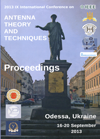Development of the theory of nanoantennas based on modulated plasmon-polariton structures
DOI:
https://doi.org/10.1109/ICATT.2013.6650691Keywords:
nanoantennas, modulated plasmon-polariton structures, mathematical models, surface impedanceAbstract
This work presents a review of development of the theory of plasmon-polariton structures and nanoantennas based on them. It shows the method for solving the problem of excitation of impedance structures, modulated by multiple periodic sequences of impulse functions by an external source of electromagnetic field. The algorithm and the recurrence formula are proposed for the construction of mathematical models of a wide class of elements of infocommunication systems based on structures with N-fold periodicity. A comparative analysis is provided of the influence of the form of impulse sequences on the formation of spatial distribution of radiation field. Parameters for the design of nanoantennas, spatial filters, interferometers, commutators, superlenses and supercollimators have been calculated.References
AGRANOVICH, V.M.; MILSA, M.D. Surface Polaritons. Moscow: Nauka, 1985, p.70-104.
http://cordis.europa.eu/fp7/dc/index.cfm.
SOMMERFELD, A. Ueber die Fortpflanzung elektrodynamischer Wellen langs eines Drahtes. Ann. Der Physik, 1899, v.303, n.2, p.233-290, doi: http://dx.doi.org/10.1002/andp.18993030202.
ZENNECK, J. Uber die Fortpflanzung ebener elektromagnetischer Wellen langs einer ebenen Leiterflache und ihre Beziehung zur drahtlosen telegraphie. Ann. Der Physik, 1907, v.328, n.10, p.846-866, doi: http://dx.doi.org/10.1002/andp.19073281003.
WOOD, R.W. Phil. Mag., 1902, v.4, n.21, p.396-402, doi: http://dx.doi.org/10.1080/14786440209462857.
FANO, U. The Theory of Anomalous Diffraction Gratings and of Quasi-Stationary Waves on Metallic Surfaces (Sommerfeld's Waves). JOSA, 1941, v.31, n.3, p.213-222, doi: http://dx.doi.org/10.1364/JOSA.31.000213.
OLINER, A.A.; HESSEL, A. Guided waves on sinusoidally-modulatted reactance surfaces. IRE Trans. AP, 1959, v.7, n.5, p.201-218, doi: http://dx.doi.org/10.1109/TAP.1959.1144771.
TALANOV, V.N. To the question of surface wave antenna's radiation with periodic impedance. Proc. of Radio Physics of USSR, 1960, n.5, p.802-807.
YEVSTROPOV, G.A. The surface waves above the ribbed surface with periodic impedance. The Questions of Radio Electronics, 1960, v.12, n.3, p.13-23.
HARVEY, A.F. Periodic and guiding structures at microwave frequencies. IRE Trans. MTT, 1960, v.8, n.1, p.30-61, doi: http://dx.doi.org/10.1109/TMTT.1960.1124658.
MILLER, M.A.; TALANOV, V.N. Use of the concept of the surface impedance in the theory of surface electromagnetic waves. Proc. Radio Physics of USSR, 1961, n.5, p.795-830.
TERESHIN, O.N.; CHAPLIN, A.F. Inverse problems of electrodynamics is symmetric with respect to the excitation impedance cylinder. Radiotechnica end Electronica, 1958, n.2.
CHAPLIN, A.F. The excitation of a impedance bandwidth on an infinite screen. Proc. of Radio Physics of USSR, 1963 n.3, p.585-590.
CHAPLIN, A.F. Excitation of periodically heterogeneous impedance structures. Works of VIII All-Union Symp. on Waves and Diffraction. Moscow: IRE AN USSR, 1981, v.3, p.73-76.
MARKOV, G.T.; CHAPLIN, A.F. Excitation of Electromagnetic Waves. Moscow, 1983, 179 p.
TERESHIN, O.N.; CHAPLIN, A.F.; SEDOV, V.M. Synthesis of antennas on the slow-wave structures. Moscow: Svyaz', 1980, 136 p.
CHAPLIN, A.F.; HOBLYK, V.V. The antenna surface wave. Patent 1078512, 1984.
CHAPLIN, A.F.; HOBLYK, V.V.; MICHAJLOV, M.Y.; YASHCHYSHYN, Y.M. The antenna surface wave. Patent RU 01805517, 1990.
HOBLYK, V.V.; GRIZAI, R.N.; FIL, R.M. The antenna surface wave. Patent UA 18767, 1997.
GOBLYK, V.V. The analysis of field above the impedance plane with periodic discrete heterogeneity by Chaplin's method/Theoretical and experimental methods for antennas and SHF devices investigations. Proc. of Lvov Polytechnic Institute, 1984, n.1874. p.27-70.
HOBLYK, V.V.; HOBLYK, N.N. About solution of the Fredholm integrated equation in a branched continual fraction type. Proc. of Int. School-Seminar on Continued Fraction, their Generalization and Application, Uzhhorod National University, 2002, p.16-18.
HOBLYK, V.V.; PAVLYSH, V.; NYCHAI, I.V. Modelling of photonic crystals by branched continual fraction. Radioelectronics and Telecommunications, 2007, v.595, p.78-86.
http://ru.wikipedia.org/wiki/.
BOLESTA, I. Surface plasmon-polaritons. Electron. and Information Techn., 2012, n.2, p.3-26.
KRASNOK, A.Y.; MAKSYMOV, I.S.; DENISYUK, P.A.; BELOV, A.E.; MIROSHNICHENKO, A.E.; SIMOVSKII, Y.S.; KIVSHAR, Y.S. Optikal nanoantenne. UFN, 2013, v.183, n.6, p.561-589.
SCOROBOGAT'KO, V.Y. The Theory of Branched Continual Fractions and Its Application in the Calculus Mathematics. Moscow: Science, 1983, 312 p.
BODNAR, D.I. Branching Continued Fractions. Kiev: Nauk. Dumka, 1986, 176 p.

